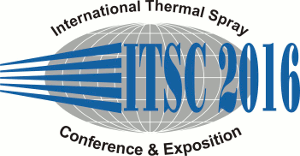
|
4837 |
|
Tuesday, May 10, 2016, Auditorium 4:30 PM Young Professionals Session |
|
Fluid dynamics and modelling of plasma jet in PS-PVD process |
|
Panpan Wang* / Jülich Forschungszentrum , Germany Robert Mücke/ Institute of Energy and Climate Research (IEK-1), Forschungszentrum Jülich GmbH, Germany Wenting He/ Institute of Energy and Climate Research (IEK-1), Forschungszentrum Jülich GmbH, Germany Georg Mauer/ Institute of Energy and Climate Research (IEK-1), Forschungszentrum Jülich GmbH, Germany Robert Vaßen/ Institute of Energy and Climate Research (IEK-1), Forschungszentrum Jülich GmbH, Germany |
|
Modelling of the supersonic compressible plasma flow has been developed to describe the thermodynamic and transport properties of the plasma spray physical vapor deposition process (PS-PVD) for typical processing parameters used for columns microstructure formation of thermal barrier coating (TBC). Commercial computational fluid dynamics software (ANSYS fluent 16.1) has been used for the simulations. The required properties of the plasma gas mixtures (Ar, He and H2) were obtained as a function of temperature and pressure from the thermodynamic calculations in chemical equilibrium (CEA program) with and without the effect of ionization. The impact of these parameters on the flow field has been studied. In all cases, the flow was found to be laminar outside the nozzle. Provided that the coating material (zirconia) evaporated completely in the nozzle, the temperature field and the resulting saturation ratio indicated that the coating material remains in fully vaporized state until it is close to the sample. The supersaturation in the direct vicinity of the sample was found to allow homogeneous nucleation of the coating material. The vapor of coating material was found to follow the plasma flow into a vortex-filled wake behind the sample, which explains the typically observed non-line-of-sight capability of PS-PVD. |